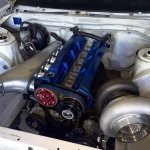No Wonder It Snaps Axles......
Announcements
-
Similar Content
-
Latest Posts
-
You can use your VIN to look up the factory part number somewhere like amayama, and then look to order new if necessary. https://www.amayama.com/en/genuine-catalogs/nissan Depending on price you might want to rebuild instead. @GTSBoy I had an interesting insight into US market parts when the Titan rear calipers were sticking. New calipers were dirt cheap, about 20% more than a rebuild kit....they are just considered throw away maintenance items
-
Funny, but really not funny. Thank god (most) f the world has moved on since then
-
Lots of votes for driving onto a plank first; that is the quickest way I've found, 25mm is enough for my case but that will vary by car It also depends where you are going for. On the 32 I can get to the rear diff with my floor jack if I do that end first, and get it up on stands. Then I lift the front from either front tow hook as high as needed, also onto stands. Sometimes I need a small lift on the other tow hook to get it level enough If I do the front first I can't get to the rear diff because of the angle of the car Other options are getting to the front mount of the rear subframe from in front of the wheel (if only lifting one side, or just do both which is a bit of a pain compared to one lift from the diff), or also the gearbox cross member mount on the driver's side if you are just trying to lift the driver's side. I This is the jack I use; it says 75mm clearance but of course that is only on the lower section so if you have to reach too far in like the diff you still get stuck. https://www.snapon-bluepoint.com.sg/category/Floor-Jacks/product/Floor-Jack,-2-Ton-Low-Profile
-
Ok so i will NEED to have this sensor anyway even with Nistune (or standalone ECU) https://justjap.com/products/genuine-nissan-boost-pressure-sensor-evap-control-system-fits-nissan-r34-skyline-c34-nm35-stagea-pnt30-x-trail-rb25det-vq25det-sr20vet?currency=AUD&srsltid=AfmBOoqfxX48bW9bEwH62orcNhtBfp7ekAL0C9Ca89ySFGUiBzXfXeze Is this the correct one? And this is only thing i need? No other "things" connected to the sensor or something? I do have the wiring.
-



Recommended Posts
Create an account or sign in to comment
You need to be a member in order to leave a comment
Create an account
Sign up for a new account in our community. It's easy!
Register a new accountSign in
Already have an account? Sign in here.
Sign In Now